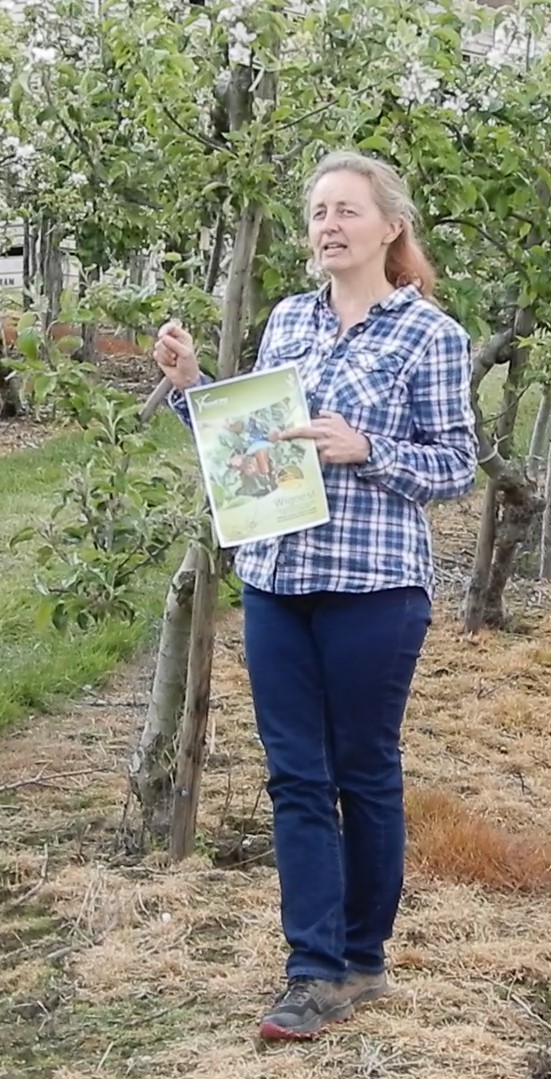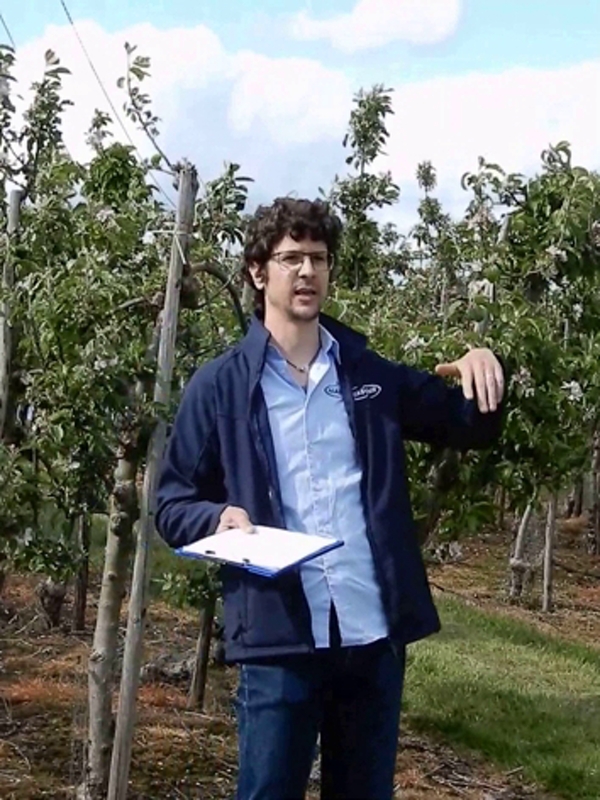

At the Recent BIFGA Technical Day, Scientists from NIAB EMR presented the latest developments in managing wildflowers and canker control.
IPM Flower Strips - Beneficial Refuges; Dr Michelle Fountain - Canker Research; Dr Matevz Papp-Rupar
Dr Michelle Fountain - Head of Pest and Pathogen Ecology - NIAB EMR
Earwig benefits and lair
 Michelle Fountain explained the benefit of introducing lairs to the young apple trees and ensuring beneficial flowers in the orchard for pollinating insects.
Michelle Fountain explained the benefit of introducing lairs to the young apple trees and ensuring beneficial flowers in the orchard for pollinating insects.
There are seven species of earwig (Order Dermaptera) in Britain. The earwig most commonly found in apple and pear orchards
is the common European earwig, Forficula auricularia. This species is an important generalist predator in the trees, regulating
populations of several damaging pest species, including aphids, mussel scale, codling moth and pear sucker.
The use and timing of plant protection product (PPP) applications probably contributes to the large differences in earwig populations found between orchards. Some products can be harmful to earwigs and there are occasions during the season when it is unavoidable to use them for the control of other damaging fruit pests.
Growers can employ strategies to avoid the use of certain harmful products at key times of the season, while also using management techniques to protect and enhance earwig populations. This guide will help growers to develop these strategies and help to construct earwig-friendly spray programmes.
In the early life of a new orchard, growers need to enhance earwig populations by providing cover to hide in during the day
and a source of food/prey for the earwigs to feed on at night. Firstly, a more complex mix of grass and wild flower species should
be sown in the alleyways to provide a mix of food including pollen and alternative insect prey.
Secondly, growers should provide refuges in the tree canopy that will allow the earwigs to hide by day and forage on food in the
trees after nightfall. Refuges can be home made and consist of old drinks bottles with the bottoms cut off and filled with corrugated
Earwig populations are generally low in orchards in their early years due to recently disturbed soil, lack of tree canopy and low
plant diversity.
Mixing wild flowers with grasses in the orchard alleyway will help to provide a mix of pollen and alternative insects for earwigs to feed on. The use of corrugated card in refuge bottles provides perfect hiding spaces for earwig.
Below: 'State of the art' Earwig lair
But Michelle introduced a new lair available for fruit growers which has an attractant inside, drawing earwigs in the locality to "set up home" in orchards. In a new orchard, Michelle advised one lair in each tree!
Michelle's presentation featured the establishment and management of wildflowers in orchards for pollinating insects to feed on and importantly be in position for apple blossom time!
This link an earlier English Apple Man Journal in 2016 explains very well the benefits of wildflowers in our apple orchards.
Click on: "Wildflowers and Pollination"
Dr Matevz Papp-Rupar - Science Project Leader - Department: Pest & Pathogen Ecology NIAB EMR
 Matevez reviewed the background of Apple canker, which is a perennial and long-standing problem of apple production. Canker study is now more than 100 years old:
Matevez reviewed the background of Apple canker, which is a perennial and long-standing problem of apple production. Canker study is now more than 100 years old:
- First "academic" report from 1877 from Germany
- First studies in the UK have started in late 1910s and early 1920s
The impact of apple canker on UK apple production has increased significantly in the last few decades. The main drivers for this are:
Higher tree density orchards of smaller spindle trained trees, enabling faster disease spread. Single cultivar orchards dominate new plantations. Dwarfing rootstocks keep trees small and compact which can lead to quicker tree death due to mainstem canker and less re-growth canker infected young fruiting wood.
New "club" varieties that are very popular with consumers are very susceptible (more susceptible than ever) Loss of approval and reduction of allowed doses of chemical products for control of apple canker (copper, tebuconazole, et al.)
High intensity nursery production of susceptible varieties using high fertiliser input for fast growth and high amount of pesticides that delay but not eradicate the cankers infections lead to higher frequency of apple canker.
The impact of Apple canker on branches decreases yield and quality. Cankers on mainstems in young trees can kill trees within the first few seasons.
Fruit can get infected during the flowering/early development and prior to harvest stages. Nectria (Eye rot) can be visible in the orchard or during after storage at packing time.
Flowers (petal scars), very young fruitlets (0-4 weeks after pollination) and mature fruit before harvest are susceptible.
About apple canker disease (Epidemiology): Fungal spores infect through wounds only. Pruning wounds and frost cracks in winter. Bud and petal scars in spring, Lenticels and cracks in the fruit in the summer. Leaf scars, picking wounds/scars in autumn.
Infected wood develops into young cankers which produce asexual spores (conidia) that spread infection locally within the tree and between neighbouring trees by rain (splash dispersal).
Late spring, summer, autumn - Older cankers (older than a year on the tree) produce sexual ascospores that are wind dispersed for few hundred meters. Autumn, winter, spring, early summer. When young cankers are cut off the tree and left on the ground, they can start producing areal ascospores within 6 weeks!
DANGER!
All you need is 30 min of rain any time of year and spores of both kinds are readily produced. The Optimal temp 5 - 15 C, but canker will sporulate down to 1 C and up to 25 C
Recent data suggest that even in very dry summer the spores can be produced after only a few hours of light rain. Most of the spores are released within 30 min after the rain event.
Wounds and inoculum are present around the year! - 4000 leaf scars per spindle tree per year - 3-30 spores are sufficient for infection. - 1000-4000 spores per mm of canker per rain event released - If left completely unchecked the canker can spread with a 4 - 10 fold year on year increase in disease incidence
Latent period / prolonged incubation period between infection and expression of symptoms can be from 3 months - 3 years
Problematic in nursery infections, high fungicide application suppressing symptom expression not eradicating canker.
Sporulation even at 1 C during storage prior to planting. Infections in a bad year often fully express in 1-2 seasons
Mainstem cankers below the first branch, developing in the first year are most likely from the nursery and should be removed to remove inoculum. No reliable method of mainstem canker eradication
Inoculum may be coming from the alternative hosts: designated Red - Amber - Green "Sound familiar"
RED: (very susceptible and high spore production): Black / grey alder, hazel, rowan, pear
AMBER: mod susceptible, high spore production: Beech, maple, aspen, elm, willow, mod susceptible, low spore production: hawthorn, hornbeam, oak
GREEN: (not susceptible and no spores produced): Ash, birch, poplar, horse chestnut, cedar, fir, cypress
Check and prune inoculum out of the hedge rows/windbreaks before planting highly susceptible new orchards. Monitor the more rows adjacent to susceptible alternative host for canker more regularly.
Wound age is critical. Fresh picking, pruning and leaf scar wounds are the most susceptible. The susceptibility of the wound to canker infection can decrease by 50% within the first 1-2 days. Weather during picking, pruning needs to be dry for a day or two after pruning/picking if possible to reduce the probability of sporulation when the wounds are still fresh.
The English Apple Man Comments:
For many years, I had believed canker moved "both ways" in the sap stream, (since my father's fruit man had shown me the brown staining in the young branches) BUT, Matt said research in New Zealand indicates canker does not move backwards in the sap stream, so when removing a branch infected with canker, a cut just a few inches below the point of infection is sufficient.
Clearly Canker is a global problem and all apple growers are challenged by this destructive disease. Irritatingly Canker is attracted to most of our most popular varieties!
The presentations by Michelle and Mat gave a clear understanding of the challenges apple growers are faced with, and an insight into how we can overcome them!
![]() That is all for this week
That is all for this week
Take care
The English Apple Man